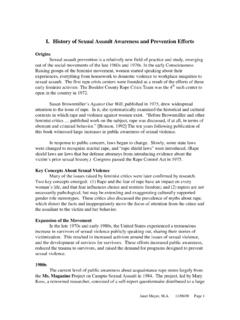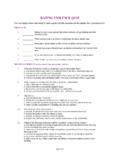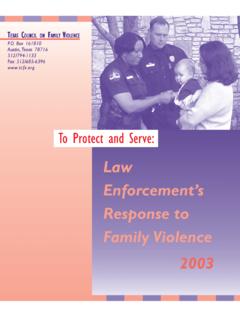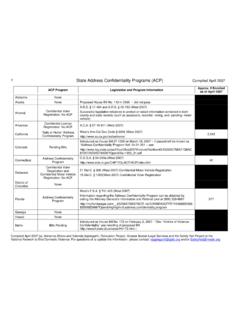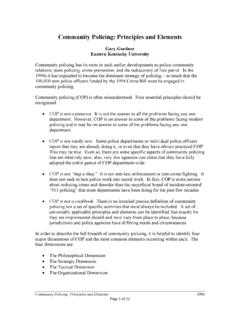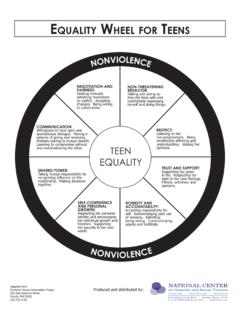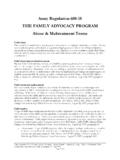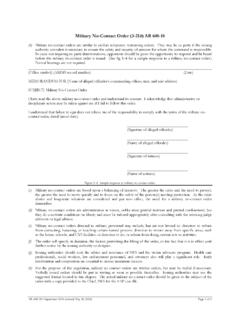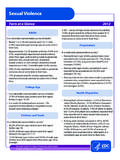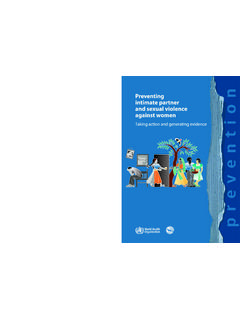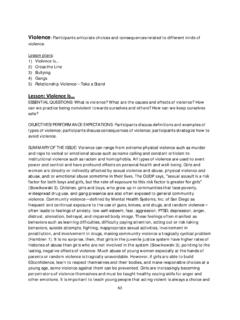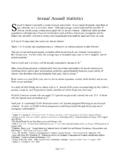Transcription of FAQ VAWA and Gender - National Center on …
1 2006 Page 1 of 3 Frequently Asked Questions about vawa and Gender : Q: Why is the bill called the violence Against Women Act? A: Senator Biden, author of the 1994 vawa , explains why the Act specifically names women: The reality is that the vast majority of victims of domestic violence are women and children, and most outreach organizations take those demographics into consideration when providing services .. The bottom line is - violence is violence no matter what Gender the victim. Because of that, the violence Against Women Act applies to all victims of domestic violence , irrespective of their Gender . Nothing in the act denies services, programs, funding or assistance to male victims of violence . 1 Q: Does the violence Against Women Act currently serve men? A: Yes. vawa funds continue to be available for services provided to victims regardless of Gender , and male victims frequently receive help from vawa -funded programs. For example, men who contact domestic violence and sexual assault programs and hotlines are provided advocacy services and legal assistance to protect their safety.
2 vawa programs also train law enforcement officers on how to respond to and assess situations of domestic violence , dating violence , sexual assault and stalking, which enhances their capacity to properly identify victims and their perpetrators. Q: Will the reauthorization of vawa improve services for men? A: Yes. Many enhancements in vawa 2005 will ensure that the original spirit of the legislation - comprehensive services to victims of domestic violence , dating violence , sexual assault, and stalking addresses the broadest range of individuals possible. In fact, the expansion of the sexual assault programs will better meet the needs of men, who experience sexual assault more frequently than domestic violence . The reauthorization of vawa will serve more men than ever before, and it will better protect more victims, men, women and teens, from victimization. Q: Who are the majority of victims of domestic violence ? A: The Bureau of Justice Statistics, National Institute of Justice, and Centers for Disease Control studies all conclude that victims of intimate partner violence are overwhelmingly female.
3 A recent study reports that women compose 84% of spouse abuse victims and 86% of victims of abuse by a boyfriend or In terms of victimization, intimate partner violence against men is overwhelming committed by male Q: Who are more likely to be victims of violent crimes committed by intimate partners? A: The Department of Justice has found that women are far more likely to be the victims of violent crimes committed by intimate partners than men, especially when a weapon is Women are 7 to 14 times more likely to report severe violence by an intimate partner, where they are beaten, choked, almost drowned, threatened with a gun, or When women use force with their intimate partners, it is most often in the context of Furthermore, a significant amount of research reports that women suffer more negative consequences as a result of violence from a current or former male partner than men do from a current or former female partner. 7 2006 Page 2 of 3 Q: What about rape, sexual assault and stalking?
4 A: Women are almost 6 times as likely as men to be victims of rape or attempted rape in their While 9 out of 10 rape victims are women, men and boys are also victimized by this Around the world at least 1 woman in every 3 has been beaten, coerced into sex or otherwise abused in her Women are times more likely to be stalked in their Q: What about studies that report equal rates of victimization between men and women? A: Most studies that report equal rates of victimization typically use the Conflict Tactics Scale (CTS), which is severely The CTS ignores the context, motivations, meanings, and consequences of intimate partner abuse. Surveys that use the CTS generally count the raw number of violent acts committed while ignoring the context of the violence . Many women resort to violence to defend themselves against the aggression of their male partners, while men generally use violence in order to control their female The CTS uses a focused, singular approach that often does not uncover the complete picture of violence and results in misleading statistics about the incidence and frequency of abuse of women as compared to Q: What about the claim that 1/3 of domestic violence victims are male?
5 A: The National violence Against Women Survey (NVAWS) is sometimes used to support the claim that 1/3 of domestic violence victims are male. This interpretation of the data is misleading. The survey is not designed to allow accurate analysis of the demographics of victims. Surveys that are designed for that purpose, such as evidence from emergency rooms, police reports, and court records, suggest that approximately 5 7% of victims of domestic violence are The NVAWS plainly states that women are significantly more likely to be victims of domestic violence . 16 CONCLUSION Ultimately, the issue of serving both men and women victims of intimate partner violence comes to resources. As we advocate for increased resources and programs through the reauthorization of the violence Against Women Act, we are also advocating for increased services to both genders with the intent of ending ALL forms of domestic violence , dating violence , sexual violence and stalking. 1 Robin Brown, Billboards criticize Biden's violence law, The News Journal (April 29, 2005).
6 2 Matthew R. Durose et al., Dep t. of Justice, Family violence Statistics: Including Statistics on Strangers and Acquaintances 1 (June 2005) 3 Stephan S. Owen & Tod W. Burke, An Exploration of the Prevalence of Domestic violence in Same-Sex Relationships, 95 Psychological Reports, Aug. 2004, at 129. 4 Diane Craven, Sex Differences in violence Victimization, 1994, Bureau of Justice Statistics Special Report (Washington, DC: Government Printing Office, 1997). 5 Patricia Tjaden & Nancy Thoennes, Dep t. of Justice, Research in Brief: Prevalence, Incidence, and consequences of violence Against Women: Findings From the National violence Against Women Survey 7 (Nov. 1998). 6 Joanne Belknap and Heather Melton, Are Heterosexual Men Also Victims of Intimate Partner Abuse? National Resource Center on Domestic violence 5 (March 2005). 7 Joanne Belknap and Heather Melton, Are Heterosexual Men Also Victims of Intimate Partner Abuse? National Resource Center on Domestic violence 5 (March 2005).
7 2006 Page 3 of 3 8 Patricia Tjaden & Nancy Thoennes, Dep t. of Justice, Full Report of the Prevalence, Incidence, and consequences of violence Against Women: Findings From the National violence Against Women Survey 13 (Nov. 2000). 9 National Crime Victimization Survey, Bureau of Justice Statistics, Department of Justice, 1996. 10 Population Information Program. Population Reports: Ending violence Against Women 2000. Population Information Program, Center for Communications Programs, Johns Hopkins School of Public Health and Center for Healthcare Gender Equity. 11 Patricia Tjaden & Nancy Thoennes, Dep t. of Justice, Full Report of the Prevalence, Incidence, and consequences of violence Against Women: Findings From the National violence Against Women Survey 18 (Nov. 2000). 12 Murray A. Straus & Richard J.
8 Gelles, Physical violence in American Families (1990); Lisa Brush, Violent Acts and Injurious Outcomes in Married Couples: Methodological Issues in the National Survey of Families and Households, Gender & Society, Mar. 1990, at 56; A. L. Cantos, Neidig, & O Leary Injuries of Women and Men in a Treatment Program for Domestic violence , Journal of Family violence , 1994, at 113; Johnson, 1995; Morse, Beyond the Conflict Tactics Scale: Assessing Gender Differences in Partner violence , violence and Victims, Winter 1995, at 251. 13 Walter S. DeKeseredy, & Martin D. Schwartz, , Measuring the Extent of Woman Abuse in Intimate Heterosexual Relationships: A Critique of the Conflict Tactics Scales 2 (1998). 14 Walter S. DeKeseredy, & Martin D. Schwartz, , Measuring the Extent of Woman Abuse in Intimate Heterosexual Relationships: A Critique of the Conflict Tactics Scales 2 3, 4 (1998). 15 R. Emerson Dobash et al., The myth of sexual symmetry in marital violence , 39 Social Problems, 1992, at 71; Michael P.
9 Johnson, Patriarchal Terrorism and Common Couple violence : Two Forms of violence Against Women, Journal of Marriage and the Family, May 1995, at 283; Maureen McLeod, Women Against Men: An Examination of Domestic violence Based on an Analysis of Official Data and National Victimization Data, Justice Quarterly, 1984, at 171; Heather C. Melton & Joanne Belknap, He hits, She Hits: Assessing Gender Differences and Similarities in Officially Reported Intimate Partner violence , Criminal Justice and Behavior, June 2003, at 328; Saunders, When Battered Women Use violence : Husband-Abuse or Self-Defense?, violence and Victims, Spring 1986, at 47. 16 Patricia Tjaden & Nancy Thoennes, Dep t. of Justice, Research in Brief: Prevalence, Incidence, and consequences of violence Against Women: Findings From the National violence Against Women Survey 6 (Nov. 1998).
